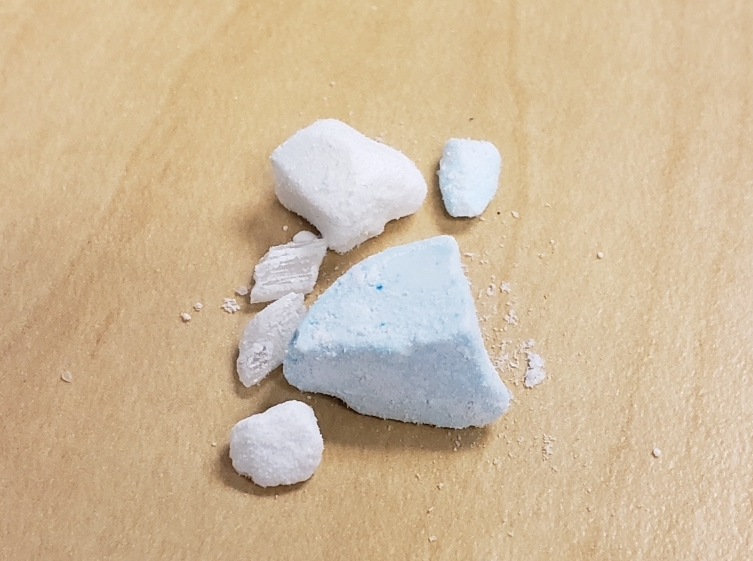
Police crackdown could worsen overdose crisis but harm-reduction strategies can help, expert says
The synthetic opioid fentanyl (chunks of white and light blue powder) mixed with stimulants such as methamphetamine (white crystals, left) is behind recent increases in overdose deaths in the U.S. (Photo by Dan Ciccarone.)
Harsh criminal charges aimed at stopping people from selling or possessing drugs may do more harm than good, a drug expert warns.
Each year, tens of thousands of Americans die from drug overdoses, most of which are linked to opioids, such as the synthetic drug fentanyl, according to the National Center for Health Statistics. A recent rise in overdose deaths is related to fentanyl, which people generally use alone or in combination with stimulants such as methamphetamine or cocaine. In some states that jump has sparked tough criminal charges — including murder—for people connected to overdose deaths.
But criminalizing people who use fentanyl, and those who try to help them, may increase overdose rates rather than reduce them, said addiction medicine physician Dan Ciccarone during the Council for the Advancement of Science Writing’s New Horizons in Science briefings at the ScienceWriters2022 conference in Memphis, Tenn., Oct. 24.
“We are not arresting our way out of this,” he said.
Instead, Ciccarone and other experts recommend strategies to keep people who use drugs safe. While studies suggest that such strategies are effective at reducing overdoses, there is still a clash between public health methods to reduce harm and law enforcement efforts to reduce the supply of fentanyl and other illicit drugs.
Incarceration can increase people’s risk of overdose, according to a 2018 study in Addictive Behaviors. That’s because going without drugs for the length of confinement lowers tolerance to the substances. Overdose can result if, after release, individuals try to use the same dose of drugs they did before.
Since the 1990s, the ongoing epidemic of overdose deaths has featured three distinct waves, associated with different substances. First came prescription opioid pills such as oxycodone. A second wave fueled by heroin soon followed, then a third wave from synthetic opioids such as fentanyl. Now, fentanyl mixed with stimulants including cocaine and methamphetamine may be driving a fourth wave of overdose deaths, researchers reported in 2021 in Preventive Medicine.
In 2017, the U.S. Department of Health and Human Services declared the drug overdose epidemic a public health emergency. That declaration keeps being renewed—most recently in January 2022—as overdose deaths continue to rise. In August, the U.S. Centers for Disease Control and Prevention released data showing that the COVID-19 pandemic helped make the overdose epidemic worse, as many people turned to drugs as a way to deal with job loss, isolation, sickness and death.
Policy makers and public health and addiction experts have looked at a variety of strategies to address substance use and drug overdose. Some, such as increasing penalties for drug-related crimes, focus on reducing supply and drug use. But use and overdose rates continue to rise. Drug purity—hence, potency —has also increased, which some experts say may be the result of laws that base criminal charges on the weight of seized substances.
“We have to think about policing policies that are effective,” Ciccarone said.
Harm reduction gains ground
The approach of protecting people who use drugs from overdosing is gaining momentum. The 2022 United States National Drug Control Strategy, released in April, calls for “meeting people where they are” and supporting policies that help people who use drugs to stay safe.
One such strategy recommended by the CDC is to ensure that people who are at high risk of experiencing an overdose — or witnessing one—have access to the drug naloxone, which can quickly reverse an overdose. Others include ongoing addiction treatment to help people maintain recovery and laws to shield people who call 911 during an overdose from arrest. The Office of Justice Programs, an agency of the U.S. Department of Justice that supports crime prevention research, in October announced grants totaling $340 million for drug treatment programs and research to reduce overdoses.
Law enforcement and public health efforts still face challenges, Ciccarone said. For example, obtaining Drug Enforcement Agency data on drug seizures for research can be a complicated process that involves knowing the right people. And death data reports from the CDC consistently lag behind overdoses by at least two months, making it difficult for officials to forecast trends and take action.
“We are not truly treating it like a crisis,” Ciccarone said. “If it was a crisis, it would be all hands on deck.”